by Kirby Lindsay Laney, posted 19 January 2011

At Fremont Antique Glass Company, they craft sheet glass using an old-fashioned process largely abandoned over 100 years ago. The work is arduous, slow and more costly – and creates beautiful, high-quality stained and/or restoration glass, one-sheet-at-a-time which allows them to craft a nearly infinite variety of colors and/or textures.
The Gather
Each week day, Jim Flanagan and his crew run through the entire process – and allowed me to observe them, twice. Flanagan also provided me with an excellent tutorial – a detailed article written by Richard L. Hoover.
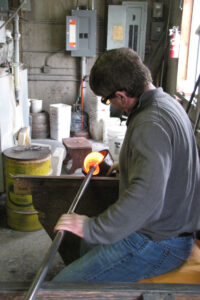
The day starts with a gather, done by Asim Kurjakovic. From a molten mixture melted in the 50 pound capacity crucible of one of the gas kilns, the Gatherer collects a small, red hot ball of (usually clear) glass on the end of a hollow, stainless steel blowpipe. After he initially centers the lava-like glass ball on the end of the five foot pipe, he blows a small bubble into its center.
Kurjakovic must continuously spin the pipe to keep the ball centered. As he ‘blocks’ the ball, to turn it into a perfect sphere, he uses several water-soaked wooden tools, cleans the surface with a scouring pad and gently cooling the glass with a fine stream of compressed air. During this part of the process, he can sit on a bench, resting and rolling the pipe on the bench’s extended arms.
Once slightly cooled, colored glass can be pressed onto the initial gather. James Musco or Asmorom Tesfi will withdraw another melted ball of glass from another, smaller furnace to add to the initial gather. Kurjakovic continues to spin and blocks the larger gather, eventually setting the glowing ball in a wooden form mold. As Tesfi or Musco wet down the mold using a water-soaked sponge, as Kurjakovic slowly twirls the pipe to keeps the red within it perfectly centered.
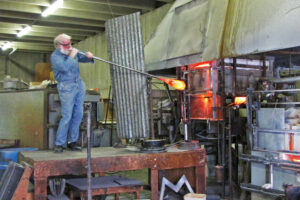
Blow A Bubble
Flanagan then steps up onto a platform before yet another gas-fired, 2,500 degree furnace, called ‘the glory hole.’ He accepts the pipe with the now 10 pound mass of glass, and warms this ball before the furnace, slowly spinning and blowing through the pipe to convert the ball into an awkward looking oval.
Flanagan blows, and occasionally shifts the pipe to vertical to swings the lengthened mass just over the floor, where gravity assists.
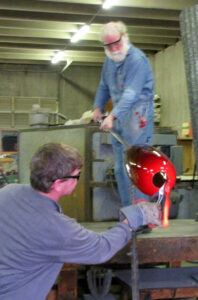
He also slips the watermelon-shaped mass into a mold alongside the platform, and deliberately rubs it along the rough surface to create striations on the glass. A final reheating will diminish these marks slightly, making them part of the polished surface texture of the glass. After final reheating, Flanagan gently taps the outrageously lengthened mass of soft glass on the floor to flatten slightly the bottom of the cylinder.
To remove the bottom of hot glass, he extends the cylinder horizontally and an assistant attaches a glob of 2,200 degree glass to the center of the flattened area. After warming it again, a slight hole melts into the cylinder and the assistant enlarges it by cutting away a circle of melting, near liquid glass that stiffens as it drops 2 feet to the floor.
Heated again in the glory hole, Flanagan again extends the cylinder and his assistant gently flares the hole using water-soaked wooden paddles and the ceaseless rotation of the pipe done by Flanagan. Flanagan climbs off the platform carrying the cylinder on the pipe.
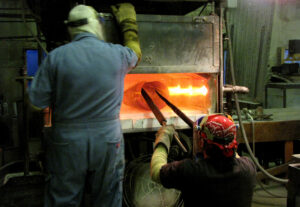
He sits on another bench with extended arms on which he rests the cooling cylinder and scores the top, where it joins with the pipe. Carrying the awkward cylinder, and pipe, he walks over to a 1,000 degree preheated annealing chamber, places the cylinder on its flared end, taps the scored top of it and sees it separate from the blow pipe with a loud crack. Meanwhile, another gather has begun and Flanagan has about 10 to 15 minutes before he will blow again.
Flatten A Cylinder
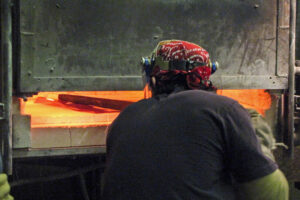
A cylinder will cool, at least overnight, before the neck is removed and the side scored to create a crack along its length. To become a sheet, it goes into another annealing oven to be reheated to 1,000 degrees. Each afternoon, Flanagan will draw single cylinders from the oven to place carefully in another direct flame gas furnace, where Brad Mayoras carefully unrolls and flattens them in the licks of the fire.
Mayoras manipulates the cylinder using water-soaked cherry wood sticks that slowly burn up due to the flames. He shifts the cylinder, evenly heating and melting the glass to get it to lay down flat on the stone floor of the kiln. Mayoras then draws a flat paddle, on a pole, from a water bucket, checks and cleans its surface, and uses it to completely smooth the glass.
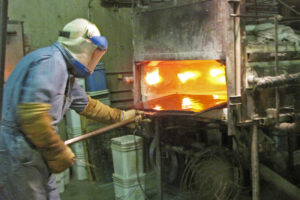
Flanagan then lifts an edge of the sheet of glass in the kiln using a stainless steel table knife, then slides the glass onto a water-soaked wooden board – in a move reminiscent of shifting pizza pie. He then slides the sheet onto one of 15 shelves in another annealing chamber.
The next day the finished, cooled sheets can be removed and Tesfi polishes off any kiln grit. The sheets of glass will shortly be shipped to distributors, for the ‘factory’ stores only a small inventory of finished sheets. Rather, they focus on the glass to be gathered, blocked, blown and flattened that day – all from their concrete warehouse in Fremont.
To watch this fascinating process, check out a video of Fremont Antique Glass Company, by Yves Trudeau, on YouTube. Also, see even more pictures on the Fremocentrist.com Facebook page.
Related Articles
- Fremont Antique Glass, A Secret 30 Years In The Making
- by Kirby Lindsay, January 17, 2011
- When Propulsion Counts More Than Pretty
- by Kirby Lindsay, July 28, 2010
©2021 Kirby Laney. This column is protected by intellectual property laws, including U.S. copyright laws. Reproduction, adaptation or distribution without permission is prohibited.

